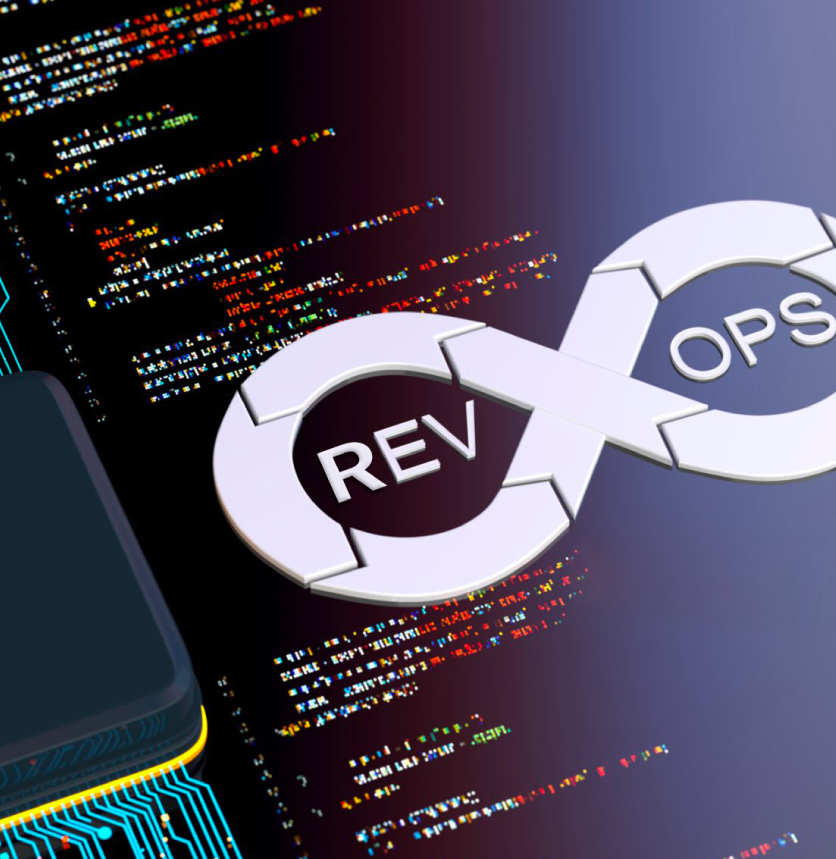
How to Scale with RevOps and Hubspot
Revenue Operations, or RevOps, is the process that is emerging in companies these days and is intended to improve their revenue and stop the leakage of profitability that happens due to the effect of operating in silos, especially in customer-facing areas. Have you already heard of the term? Now that you've seen that it can help your business earn more and be more profitable, we'll explain in detail how.
The goal of RevOps is to help companies improve their bottom line by integrating different business areas, such as marketing, sales and customer service. This is achieved through the automation and optimization of key processes in each area, such as lead generation, sales opportunity management and customer lifecycle tracking.
RevOps also includes managing and analyzing data to gain a deeper understanding of the company's customers and operations, and using that information to make informed business decisions and improve efficiency and performance over time.
What is RevOps?
RevOps is a shortened term for Revenue Operations, which refers to the combination of strategies, processes and tools used to optimize and maximize a company's revenue stream.
How does RevOps work?
RevOps uses techniques and tools to integrate and optimize key processes in different areas of the business. Some of the key tasks in RevOps include:
-
Lead generation:
attracting potential customers and converting them into qualified leads. -
Sales opportunity management:
tracking and managing sales opportunities throughout the sales lifecycle. -
Customer lifecycle tracking:
tracking and managing the customer lifecycle, from acquisition to retention and growth. -
Data management and analysis:
data collection and analysis to gain a deeper understanding of the company's customers and operations, and use that information to make informed business decisions.
You may be wondering what the difference is between RevOps and what your company currently does in areas such as marketing, sales and service delivery. Well, that's the point: Revenue Operations, or RevOps comes in to uncover, expose and fix the intrinsic and less-than-obvious flaws that result from keeping these teams, which together are the engine of growth and scale for your company, administratively and functionally separate.
Marketing, sales and service have one thing in common: your customer. And any operation involves transfer points: Marketing has to transfer prospects to sales; sales has to transfer customers to the service and operation team, and service and operation have to deal with complaints, questions, incidents that, in most cases, are due to frictions generated in the other processes and remain without being fed back. But there are also transfers to billing, to portfolio and from these to services, which do not always work and complicate the life of your customers or your team.
This may simply be the landscape you are used to seeing in your company, but it is the one that RevOps promises to change. In such a landscape there are not only frustrated people (most of the time it's your customer) but overworked and just as bad, lost money.
How will RevOps impact the future of sales?
By breaking down silos between sales, marketing and customer service teams, RevOps enable strategic alignment and a holistic view of the customer lifecycle.
This means companies will be able to maximize revenue, optimize processes and deliver exceptional customer experiences.
RevOps will increase sales efficiency and effectiveness, driving sustainable growth and competitive differentiation in the marketplace. The future of sales will be shaped by synergy between teams and the ability to adapt quickly to changing customer needs.
With RevOps, companies will be prepared to meet the challenges of the future and achieve new levels of success in their sales strategies.
How do you know if your business needs a RevOps model?
If you own a business, you've probably heard about the RevOps model, which has become a trend in the business world. But how do you know if your business needs a RevOps model? Here are some signs to look out for:
-
The sales process is complex
If your company has a complex sales process that involves several areas of the business, from marketing to sales to customer service, then a RevOps model might be the right solution to coordinate and optimize the workflow.
-
Cross-team collaboration issues
If your business faces cross-team collaboration issues, such as uncoordinated project delivery, miscommunication and interdepartmental conflict, a RevOps model can help break down barriers and create a more integrated and collaborative approach.
-
Difficulties in data measurement and analysis
If your company struggles with measuring and analyzing sales and marketing data, a RevOps model can provide a structure for data collection and analysis, which in turn can improve data-driven decision making.
-
Customer experience management issues
If your business is struggling with customer experience management, a RevOps model can help optimize the sales process and improve customer satisfaction through better coordination of sales, marketing and customer service teams.
-
Lack of focus on profitability
When the brand focuses more on sales volume rather than profitability, a RevOps model can help focus on efficiency and profitability, which can improve long-term financial results.
-
Difficulty meeting sales and growth targets
If your business is struggling to meet sales and growth objectives, a RevOps model can help align objectives across all areas of the business and improve efficiency in achieving goals.
-
Technology integration issues
When you are struggling with technology and systems integration, a RevOps model can help ensure effective implementation and adoption of new technologies and tools for business growth.
If your company is experiencing any of these signs, a RevOps model may be the right solution to improve efficiency and business growth. This approach focuses on coordinating and optimizing all areas of the business to maximize efficiency and financial results.
The main objective of the RevOps model is to align sales, marketing and customer service areas to create an integrated and collaborative approach.
3 benefits of RevOps for businesses
The main benefit of RevOps is to catapult the momentum when a company scales or print the necessary efficiency in revenue management.
Here are the benefits associated with a proper RevOps strategy:
Improved financial performance 2.
One of the main benefits of RevOps is that it helps improve a company's financial performance. What RevOps does is to propose a panoramic view to the teams responsible for the company's revenue: marketing, sales and service, and thus integrate and optimize processes. In doing so, the impact is felt in increased revenue and reduced costs.
2. Increased efficiency and productivity
RevOps can also help companies increase efficiency and productivity. By automating and optimizing key processes, you can reduce the time and effort required to perform tasks and increase overall efficiency.
3. Customer lifecycle optimization
RevOps can also help companies optimize the customer lifecycle, from acquisition to retention and growth. By effectively tracking and managing the customer lifecycle, companies can increase satisfaction and foster loyalty, which can increase the long-term value of each customer.
How companies use RevOps (Examples)
Here are some examples of how companies have used RevOps to improve their bottom line:
Example 1: Integration of marketing, sales and customer service.
Everything a person does in a company within a marketing, sales or service team generates data. And every cross-team or cross-stage process generates conversion rates. A good way to use RevOps in a company is to survey the marketing, sales and service processes (support, customer care, service delivery) to detect waste, unnecessary steps or redundant customer touch points. It is essential to entrust this to an impartial team, which can be the Revenue Operations team (we will tell you how you can form it later on), since the processes must be viewed holistically in relation to the user experience. As we saw above, the results of such an exercise result in savings or revenue for the company.
Example 2: Using Data to Make Informed Decisions
A HubSpot Academy interview with Matt Volm, founder of Funnel IQ shows how detailed analysis of a client's Marketing Qualified Leads (MQL) decay curve helped increase the conversion rate to Sales Qualified Leads (SQL) by better focusing SDR (Sales Development Representative) efforts on only the newest prospects.
"We took a cohort and analyzed it day by day. How many went on to the next phase? After day four we started to see very little conversion (...) We watched and realized that most of the MQLs were exhausted by day four, which was day nine, in terms of seniority, but the SDR team was working well into the ninth and tenth day to try to get a meeting."
The decision they made then was to focus on the new leads coming in, as we explained above. And by doing that, it improved the conversion rate from MQL to SQL from 33% to 45%.
How to implement RevOps in your business?

If you want to implement RevOps in your business, here are some steps you can follow, as long as you set goals that your marketing, sales and service areas share with each other.
Keep in mind that RevOps is about mobilizing actions aimed at maximizing revenue by intervening in processes related to customer attraction and retention. In other words, all those that drive the cash register.
In that order of ideas, your objectives may be related to demand generation, lower acquisition costs, increase customer Lifetime Value, optimize the sales cycle, improve customer experience, repurchase or renewal, among others.
Steps to implement RevOps in your company
-
Analyze and clean up the tech stack:
according to a 2021 report on the Software as a Service (SaaS) industry market published by Finances Online, one of the great challenges for companies is the management of technological applications under the SaaS modality. According to a survey cited in the report, one of the biggest challenges facing IT leaders (49%) is the expansion and management of the number of apps within companies, as well as the detection of unmanaged applications and the spending that goes with them (14%). Already in 2020, a report published by Blissfully talked about that in the mid-sized company market, there are on average 137 different SaaS apps while in the enterprise or corporate market the number reaches on average 288.
This is the scenario that Revenue Operations faces as a strategy, role or team within a company and the path that points out the first working steps.
From the analysis of the technological stack should come an inventory of tools and functions, a debugging plan to get rid of unmanaged tools and those that duplicate functions between areas and, most importantly, a plan for data integration and migration.
-
Integrate and migrate:
the backbone of any Revenue Operations exercise is the cleansing of data and the transit of data across the tools that support the key functions of the company's growth. We are talking about applications for marketing management, customer and business management, service operation and customer care, and billing.
From this point of view, it is necessary to build a roadmap of integrations that prioritizes the most critical points where frictions with customers and revenue generation have the greatest negative impact.
It is also essential to establish a policy for managing the company's tech stack, given the constant evolution of business needs and tools.
-
Establish data governance policies:
Once the management of technological applications has been defined and the integration points have been established and developed, the most important thing is to establish internal data governance policies. That is, the rules that will define the availability, usability, integrity and security of the data contained in the applications and in transit between them.
One tool to achieve this is documentation through a data dictionary, which documents the fields in the systems and how they relate to each other. In a data dictionary, issues such as the following are related:
- The names of the fields that house data in the systems and their function.
- How data is integrated across tools.
- In which direction the data flows.
-
Integrate and optimize your key processes:
It is good that this step runs parallel to the others, since technological tools and data must be subordinated to processes that you have optimized in order to reduce friction and gain efficiencies.
The main gains for the company by taking this step are:
- Document marketing, sales and service processes as they are today.
- Define the ideal processes and how they are linked together, i.e., what data flows between them, what roles are related and what information is delivered and returned under service level agreements established according to shared goals.
- Implement the processes in the technology stack tools.
- Carry out appropriate communication and change management processes.
-
Use data to make informed decisions:
Another way you can use RevOps is by collecting and analyzing data about your customers and your operations. This will help you make informed decisions about how to improve your business and maximize your bottom line.
Tools and resources for implementing RevOps

RevOps To implement RevOps in your business, it is important that you have the necessary tools and resources. Some tools and resources that may be useful include:
- Marketing automation tools: CRMs like HubSpot or automation platforms like ActiveCampaign, which help you automate and optimize key marketing tasks.
- Lead management tools: such as HubSpot, Salesforce or Pipedrive, which help you track and manage leads throughout the sales lifecycle.
- Customer lifecycle tracking tools: such as Zendesk or Intercom, which help you track and manage the customer lifecycle from acquisition through retention and growth.
- Data analytics tools: Another way you can use RevOps is by collecting and analyzing data about your customers and your operations. To do this, you can use data analytics tools such as Google Analytics or Tableau. These tools will help you collect and analyze data about your website traffic, customer behavior, and the performance of your marketing campaigns, among other things. With this information, you can make informed decisions on how to improve your business and maximize your bottom line.
How to measure RevOps performance?
To measure RevOps performance, it is critical to establish clear and objective metrics that reflect business results and operational efficiency. By defining specific and measurable metrics you will be able to evaluate progress and properly track performance.
Some key metrics for measuring RevOps performance include sales close velocity, value of opportunities generated, lead conversion rate, average sales cycle time and customer satisfaction. These metrics provide a complete picture of how the RevOps team is contributing to business results and allow you to identify areas for improvement.
In addition, it is important to ensure that the data used for RevOps analysis is quality and up-to-date. This involves maintaining an accurate and reliable database, and performing regular checks to verify data integrity. Monitoring data quality ensures that decisions are based on accurate and reliable information.
Finally, it is important to regularly review metrics and compare results against established objectives to identify areas for improvement and make informed decisions to optimize RevOps performance. This involves making adjustments to processes, training staff or implementing new strategies as needed.
In short, RevOps is a discipline that helps companies optimize and maximize their revenue stream by integrating and optimizing key processes in different areas of the business and using data to make informed decisions. By implementing RevOps in your company, you can improve financial performance, increase efficiency and productivity, and optimize the customer lifecycle. If you want to implement RevOps in your company, make sure you keep your objectives in mind, integrate and optimize your key processes and use data to make informed decisions, and use the right tools and resources to do so.
Frequently Asked Questions about RevOps or Revenue Operations
How did Revenue Operations came up?
Revenue Operations refers to the alignment of Marketing, Sales, and Customer Service teams that work as “an orchestra” playing “the same tune” so that the customer “enjoys the concert and comes back for more.”
How to implement automation to succeed in RevOps?
It is necessary to use automation to optimize entire processes, be strategic in determining who will be in charge of implementing automation processes, and continuously integrate and improve.
Why is automation important for revenue management?
Through automation, you can increase the efficiency of many crucial functions that engage the team or teams responsible for generating revenue.
Periodista de la UPB, master en comunicación y periodismo digital de la universidad Carlos III de Madrid e inbound marketer. Catalina fue macro editora general de El Colombiano, es mamá de Gregorio y Agustín, y de dos perros: Maraca y Timbal. Actualmente es nuestra subgerente de operaciones.
Triario's Blog
Subscribe to our Blog and don’t miss anything!
¿Te gusta nuestro contenido?
Publicamos nuevo contenido cada semana. Suscríbete aquí y mantente al día con las noticias más relevantes del marketing digital.






